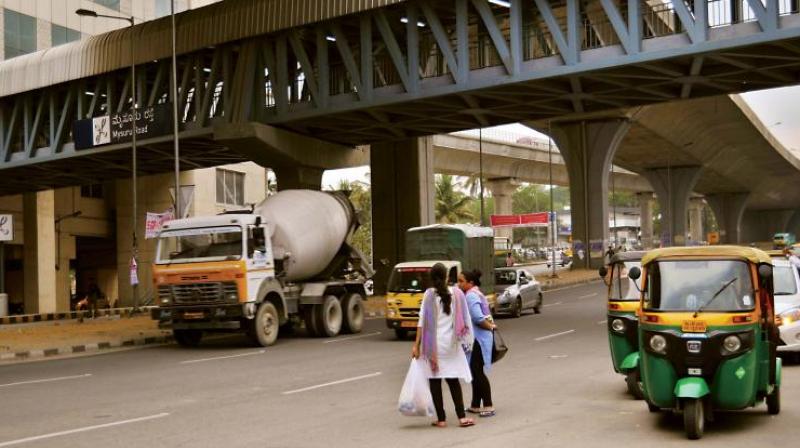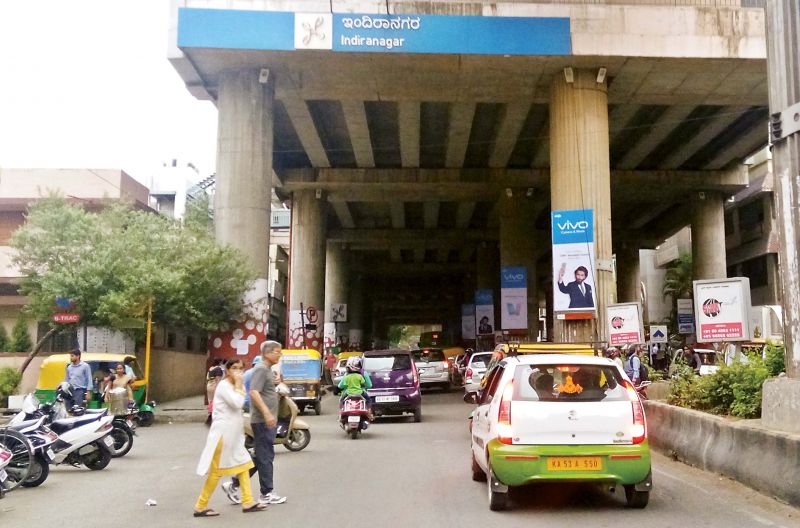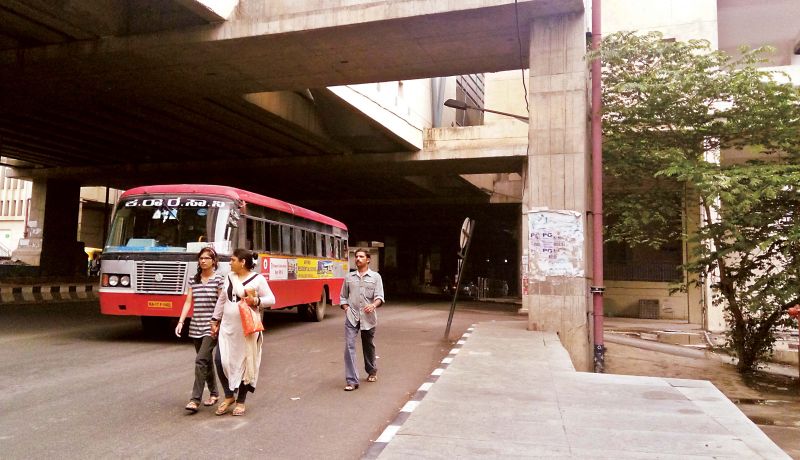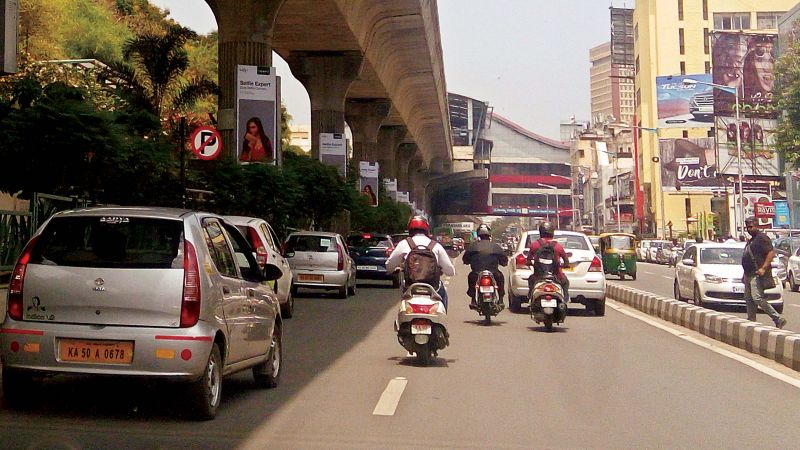Ride Namma Metro or die trying!

In April, a student crossing the road from Nagasandra Metro Station was killed by a speeding vehicle. Although the Namma Metro is very convenient, accessing the stations shouldn’t be a matter of life and death. Skywalks are too small to be of much use and roads lack pedestrian crossings. Authorities say TenderSURE pavements will be built, but accessibility should have been planned first, reports Ranjani Madhavan.
The good news is that after missing several deadlines, Metro Phase 1 could soon be fully operational. But the bad news is passengers hurrying to board the trains don’t have safe pedestrian access to the stations. The result was fatal for at least one passenger. A college girl crossing the road from the Nagasandra Metro station was killed by a speeding vehicle in April. What’s troubling, however, is that nothing has changed since then and pedestrians remain as vulnerable to the oncoming traffic near most Metro stations.
Mr Rajashekar, father of the young girl run over by the vehicle in Nagasandra, recalls that she was returning from college and was crossing the road after alighting from the Metro, when she was hit. Sadly, the authorities have taken no precautions since to prevent accidents at the spot, he laments. “It’s difficult for anyone to cross the road here even now. The BMRCL had promised to build a subway at the spot some 10 months ago but no work has started yet," he regrets.
The risk remains high for pedestrians both on the existing Purple and Green lines, note experts. They believe the solution could lie in broad footpaths on roads leading to the stations, as well as in subways or skywalks for use of passengers.
Although the plan was to improve accessibility to Metro stations by building TenderSURE footpaths around them, you don’t find any matching this description in their vicinity. Ask BBMP Chief Engineer, Prahalad and he has a new term for what the public can expect. “We are building Light TenderSURE footpaths around Metro stations on the elevated corridors. No utilities or pipelines will be shifted and no cycle lane provided like on the usual TenderSure roads. Only broad footpaths will be built around the elevated corridors, but not near the underground Metro stations,” he explains. What this means is that passengers hurrying to major underground stations like the Kempegowda , Vidhana Soudha, M Visveshwaraya, Cubbon Park, and City Railway will have to make do with the current narrow footpaths. And those heading for the still to be opened Green Line underground stations on the North-South Corridor too will remain at similar risk.
Peenya: Three underpasses promised, but none are ready
Peenya - Nagasandra
BMRCL promised subway access to all Metro stations from Peenya to Nagasandra, but there is no sign yet of the three planned underpasses near the Peenya, Dasarahalli and Nagasandra Metro stations.
"Around 2000 people living in Vinayak Nagar cross the roads on these stretches to use the Nagasandra and Peenya Metro stations to either make their way to college, school or work. There are no signals or speedbreakers and people will not walk one kilometer to use the skywalk," points out Mr Rajashekar, who lost his daughter to an accident at the spot last month.
Sandal Soap Factory
The pavements on the road leading to the Sandal Soap Factory Metro station in Yeshwanthpur are in a pathetic condition. The footpaths disappear at certain points with local hotels encroaching on them for customer parking. As a result commuters often cross the signal-free road, risking their lives, or end up climbing over the high platform on which the Metro viaducts rest in the middle of the road.
Pillars, heavy vehicles mar access to Trinity Circle, Mysuru Rd stations
Mysore Road Metro Station
“The Mysore Road Station is like an island surrounded by fast moving heavy vehicles on the highway and Outer Ring Road. People find it difficult to reach the station by foot and so are ready to pay and park but not walk the one kilometer distance," observes Mr. Srinidhi, member of advocacy group, Praaja RAAG.
 Entrance to Indiranagar Metro Station
Entrance to Indiranagar Metro Station
Noting the absence of a footpath all around the Mysore Road Metro Station, he believes either a subway or skywalk is essential at the spot for the convenience of commuters. “When such elevated stations have viaducts in the middle of the road with vehicles speeding in both directions, how can a commuter walk safely across to them?" he asks pertinently.
Trinity Road Metro Station
Commuters have no safe access to the Trinity Road Metro station in the Central Business District either. Although it too has viaducts (pillars) running through the middle of the road, there is neither a subway nor skywalk to help passengers get across.
“People are reluctant to walk half a kilometer to the zebra crossing at the traffic signal and then make a U- turn to reach the station. They would rather run across the busy road, risking their lives,” Mr Srinidhi observes.
MG Road Metro Station
Anyone who has visited the MG Road station finds only narrow pavements encroached on by vendors and petty shops near it." MG Road has only a normal footpath. The work happening right now is merely to upgrade the footpath with blocks and cement. TenderSURE, on the other hand, requires the right kerb height, right footpath width, shifting of utilities and so on. It was a good plan and both the BMRCL and BBMP were supposed to get everything done. But where has the idea gone? Who hijacked the plan?” asks Mr Srinidhi, adding, “ It is in the BMRCL's business interests to provide good accessibility to its stations as it will boost both ridership and revenue."
BBMP Chief Engineer, Prahalad admits that the footpaths near the MG Road and Vijayanagar Metro stations are not being re-done to TenderSURE standards. “What we are aiming at are Light TenderSURE footpaths. We are not shifting the utilities and pipelines or providing a cycle lane,” he explains.
Access to Trinity Circle a challenge: BMRCL
The only station where pedestrian access has been given its due is the KR Market Metro station where the Directorate of Urban Land Transport in collaboration with the Bengaluru Metro Rail Corporation Ltd( BMRCL) is developing all five entrances as gateways to the streets of old Bengaluru. The plan involves pedestrian -centric footpaths and safe access to all roads, public utilities, hospitals and tourist spots in its vicinity.
While applauding the design, Mr. Srinidhi, a member of advocacy group, Praaja RAAG, says having safe access to KR Market station alone is not good enough. "The BMRCL must provide safe access to all other stations with cross-over bridges and good footpaths. This should be the focus of Phase 2,” he stresses.
Agreeing that pedestrian accessibility is critical for the Metro, Chief Public Relations Officer of the BMRCL, Vasanth Rao says the BBMP is splitting costs with it to build TenderSURE footpaths around the stations to provide last mile connectivity.
But point out to him that the footpaths around the underground stations will not get a TenderSure makeover and he argues those around the Cubbon Park, Vidhana Soudha, and other underground stations are in good shape and don’t need to be redone.
As for the delay in building the subways near the Peenya, Nagasandra and Dasarahalli metro stations, he says the NHAI has not yet approved the BMRCL's design for them and work will begin once the clearance is received.
But ask him about the access to the Trinity Metro station and he agrees that this is a bit of a challenge. “There is no way we can build a subway or a skywalk here. People, including those who are not heading for the Metro, are, however, free to use the station concourse to cross over to the other side. The only hassle is they will have to go through the frisking. But they can make use of this option instead of running across the road in the face of traffic," he says.
Connect skywalks to major destinations: Dr. Ashish Verma, Mobility expert and IISc Professor
While access to the Metro Rail is really bad at present, it doesn't mean it cannot be improved. The first thing we have to look into is the distance people are willing to walk to reach the stations. Research reveals that this 'Acceptable Trip Distance' is 0.5 to 1 km. BMRCL has to take this into consideration and focus on how people can reach the stations by foot. In Phase 1 all Metro stations are around 1 km apart from each other. This provides a catchment area of 0.5 kms on either side for the Metro to tap into.
Presently, with the Metro located in the middle of the road in most areas, people keep running from one side to the other when crossing to reach it. They must be given an incentive to use the elevated or underground path as you cannot make people climb stairs just for a distance of 7 to 10 meters. One solution is to connect the skywalks to other major destinations in the area. If there are colleges, schools, malls or offices adjoining the Metro station, they can be connected directly with the skywalk. Unless we create the above incentives, Metro's ridership will not increase, but the risk factor will.
There doesn’t need to always be an over or under-way to help people cross over. If there is less volume of people, simple road signals can be used by pedestrians. We will need grade separators only if there is a high population near the stations.
While normally, safe pedestrian access is planned before building the Metro, it can still be done with some re-modelling. Someone has to take a call as this is not impossible.



